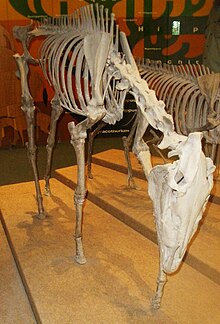Dinohippus
| Dinohippus | |
|---|---|

| |
| Dinohippus leidyanus skeleton | |
| Scientific classification | |
| Kingdom: | Animalia |
| Phylum: | Chordata |
| Class: | Mammalia |
| Order: | Perissodactyla |
| Family: | Equidae |
| Subfamily: | Equinae |
| Tribe: | Equini |
| Genus: | †Dinohippus Quinn, 1955 |
| Type species | |
| Pliohippus leidyanus | |
| Species | |
| |
Dinohippus (Greek: "Terrible horse") is an extinct equid which was endemic to North America from the late Hemphillian stage of the Miocene through the Zanclean stage of the Pliocene (10.3—3.6 mya) and in existence for approximately 6.7 million years.[1][2] Fossils are widespread throughout North America, being found at more than 30 sites from Florida to Alberta and Panama (Alajuela Formation).
Taxonomy[]

Quinn originally referred "Pliohippus" mexicanus to Dinohippus, but unpublished cladistic results in an SVP 2018 conference abstract suggest that mexicanus is instead more closely related to extant horses than to Dinohippus.[3]
Description[]
Dinohippus was the most common horse in North America and like Equus, it did not have a dished face. It has a distinctive passive "stay apparatus" formed from bones and tendons to help it conserve energy while standing for long periods. Dinohippus was the first horse to show a rudimentary form of this character, providing additional evidence of the close relationship between Dinohippus and Equus.[4] Dinohippus was originally thought to be a monodactyl horse, but a 1981 fossil find in Nebraska shows that some were tridactyl.[5] The species D. leidyanus had an estimated body mass of approximately 200 kilograms (440 lb).[6]

References[]
- ^ Paleobiology Database: Dinohippus basic info.
- ^ Bruce J. MacFadden: Cenozoic Mammalian Herbivores from the Americas: Reconstructing Ancient Diets and Terrestrial Communities. Annual Review of Ecology and Systematics, Vol. 31, (2000), pp. 33-59
- ^ http://vertpaleo.org/Annual-Meeting/Annual-Meeting-Home/SVP-2018-program-book-V4-FINAL-with-covers.aspx
- ^ Florida Museum of Natural History
- ^ Horse Ecology
- ^ M. Mendoza, C. M. Janis, and P. Palmqvist. 2006. Estimating the body mass of extinct ungulates: a study on the use of multiple regression. Journal of Zoology
- Miocene horses
- Miocene odd-toed ungulates
- Pliocene horses
- Prehistoric placental genera
- Messinian life
- Tortonian life
- Piacenzian extinctions
- Miocene mammals of North America
- Pliocene mammals of North America
- Blancan
- Hemphillian
- Neogene Costa Rica
- Fossils of Costa Rica
- Neogene Mexico
- Fossils of Mexico
- Neogene Panama
- Fossils of Panama
- Neogene United States
- Fossils of the United States
- Fossil taxa described in 1955